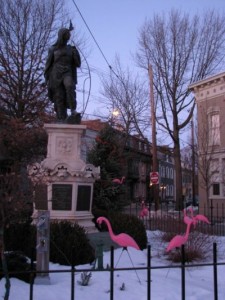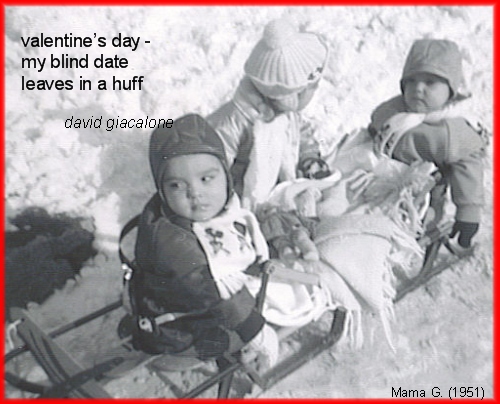 .. The tired old fogies at f/k/a want to thank the energetic Scott Greenfield for covering the latest Schenectady cop scandal at his Simple Justice weblog, so we won’t have to think too hard this morning. See “Even Cops Need Some Sleep” (Feb. 19, 2009)
.. The tired old fogies at f/k/a want to thank the energetic Scott Greenfield for covering the latest Schenectady cop scandal at his Simple Justice weblog, so we won’t have to think too hard this morning. See “Even Cops Need Some Sleep” (Feb. 19, 2009)
- Teaser: Schenectady Police Officer Dwayne Johnson made three times his base pay last year, while averaging 75 hours a week on the clock (making him, at $168,000, the highest paid employee in Schenectady’s history). However, after several late-night stakeouts, Schenectady Gazette reporter Kathleen Moore reported yesterday that Officer Johnson has been parking his car outside a local apartment that is not his home for a few hours every Tuesday night since November, during his patrol shift. Despite being tracked by a GPS monitor in his unit, no supervisor caught the apparent dereliction of duty. See “Chief: Cop ‘stealing time’: Johnson, tops in pay, out of car during shift” (by Kathleen Moore, Feb. 18, 2009).
Responding to the question from Schenectady Police Chief Mark Chaires, “how dumb can you get?”, Scott points out that “neither Chief Chaires nor anybody else on the force thinks that somebody ought to take the occasional gander at their top earner, the big money man, to make sure they are getting their money’s worth?” Scott then muses: “How dumb? Not as dumb as you, Chief.”
![]() Follow-ups today (Feb. 19, 2009): “Cop case probed for collusion: Chief wants to know why supervisors didn’t notice AWOL officer’s absences” (Daily Gazette , Feb. 19, 2009); “Editorial: In Sch’dy, Car 10, where are you?” (Daily Gazette, Feb. 19, 2009; “He deserves to be fired, and anybody but a union officer or lawyer, or perhaps arbitrator, would agree.”); “High-paid cop accused of slacking off” (WNYT/CH.13, Feb. 18, 2009, with video); “Did Schenectady’s $168G cop spend hours away? Schenectady probes whether highest-paid officer was at apartment while on duty” (Albany Times Union, February 19, 2009); “Tarnishing the badge: A decade of trouble for Schenectady police” (Times Union, by Paul Nelson, Feb. 19, 2009)
Follow-ups today (Feb. 19, 2009): “Cop case probed for collusion: Chief wants to know why supervisors didn’t notice AWOL officer’s absences” (Daily Gazette , Feb. 19, 2009); “Editorial: In Sch’dy, Car 10, where are you?” (Daily Gazette, Feb. 19, 2009; “He deserves to be fired, and anybody but a union officer or lawyer, or perhaps arbitrator, would agree.”); “High-paid cop accused of slacking off” (WNYT/CH.13, Feb. 18, 2009, with video); “Did Schenectady’s $168G cop spend hours away? Schenectady probes whether highest-paid officer was at apartment while on duty” (Albany Times Union, February 19, 2009); “Tarnishing the badge: A decade of trouble for Schenectady police” (Times Union, by Paul Nelson, Feb. 19, 2009)
update (Feb. 20, 2009): The Gazette tells us this morning that Officer Johnson was “suspended without pay Thursday while the department investigates the extent of his absences during his overnight patrols.” He apparently will have to be paid if kept on suspension longer than 30 days. “Absent officer out for month: Bennett begins cop AWOL probe; union issues cited” (Feb. 20, 2009). I’m surprised that Public Safety Commissioner Wayne Bennett believes “it will take well over a month to finish the investigation into Johnson’s absences. Also under review are the supervisors who did not notice them and the officers who may have tipped him off when internal affairs attempted to catch him in the act early last Tuesday.” I’m not surprised that he expects the police union to argue napping has become a “past practice,” approved regularly by lower-level supervisors, that cannot be changed without union approval.
![]() The Gazette notes that “Some officers, who spoke anonymously, say everyone who works long shifts takes naps, beginning at lunchtime. They argued that an unspoken rule in the department allows napping to continue after lunch as long as police get up as soon as they get a call.” Bennett says: “If someone had the absolute and unmitigated gall to call [napping] a past practice, well, supervisors do not have that kind of authority to authorize that.”
The Gazette notes that “Some officers, who spoke anonymously, say everyone who works long shifts takes naps, beginning at lunchtime. They argued that an unspoken rule in the department allows napping to continue after lunch as long as police get up as soon as they get a call.” Bennett says: “If someone had the absolute and unmitigated gall to call [napping] a past practice, well, supervisors do not have that kind of authority to authorize that.”
In his update this morning at Simple Justice, Scott Greenfield trumpets “The new frontier for police contracts: Napping Clauses.”
Officer Johnson is 49 years old and apparently considers a double shift to be his regular work day. The f/k/a Gang understands the need to nap (although, altogether, we alter egos aren’t working 75 hours a week), but we agree with the Gazette that if the conduct is proven, Officer Johnson should be fired. At the very least, some major auditing of his time records is needed, plus more scrutiny of his so-called supervisors.
Undercover? Lawyer Greenfield concludes: “But don’t fear that Johnson will go unpunished. My bet is that his wife will have a few questions about what he was doing in that apartment every Tuesday morning.”
 We don’t get paid overtime (nor anytime) here at f/k/a, but we’re always workin’ hard trying to bring you some of the best haiku around. As promised yesterday, here are poems written by a few of our Honored Guest Poets that were selected for the newest issue of Frogpond [Vol. 32:1, Winter 2009]. We’ll have another batch later this week.
We don’t get paid overtime (nor anytime) here at f/k/a, but we’re always workin’ hard trying to bring you some of the best haiku around. As promised yesterday, here are poems written by a few of our Honored Guest Poets that were selected for the newest issue of Frogpond [Vol. 32:1, Winter 2009]. We’ll have another batch later this week.
turning back on a dead end street —
one odor changes
another
… by Gary Hotham – Frogpond Vol. 32:1 (Winter 2009)
heat lightning the crooked split in the watermelon
… by w.f. owen – Frogpond Vol. 32:1 (Winter 2009)
second honeymoon 
a flock of turnstones
skirt the shore
dry spell
a field sparrow flashes
burnt umber
… by Tom Painting – Frogpond Vol. 32:1 (Winter 2009)
full moon–
I finally share the secret
with my cat
….. by Alice Frampton – Frogpond Vol. 32:1 (Winter 2009)
fallen leaves
ornament
the small fir
the barren windbreak sifting a rainy fog
…. by Tom Clausen – Frogpond Vol. 32:1 (Winter 2009)
winter night 
the heat comes on
between us
a retinal sun
wanders through
the observation car
… by John Stevenson – Frogpond Vol. 32:1 (Winter 2009)
our long bathtub soak — ![]()
a ring around
the moon
…. by David Giacalone – Frogpond Vol. 32:1 (Winter 2009)
 p.s. Speaking of criminal justice in Schenectady, the print version of the Daily Gazette has an article on p. B3 titled “Imposter [sic] suspect in Regents exam faces lesser charge” (Feb. 19, 2009). In it we learn that District Attorney Robert Carney won’t be charging Deandre M. Ellis with burglary [illegally entering a building intending to commit another crime] for entering a Schenectady school to take a Regents exam in disguise for another student. We were doubtful of the arresting officers’ legal reasoning in a post on Jan. 29, 2009 (scroll to second story). Instead, Ellis is being charged with misdemeanor criminal impersonation, which he denied at his arraignment yesterday. DA Carney explains that “There has to be some sort of notice or communication to [a] person that ‘you’re not welcome’ to convert [entering a public building like a school] to a trespass,” on which to hang a burglary count. According to the Gazette:
p.s. Speaking of criminal justice in Schenectady, the print version of the Daily Gazette has an article on p. B3 titled “Imposter [sic] suspect in Regents exam faces lesser charge” (Feb. 19, 2009). In it we learn that District Attorney Robert Carney won’t be charging Deandre M. Ellis with burglary [illegally entering a building intending to commit another crime] for entering a Schenectady school to take a Regents exam in disguise for another student. We were doubtful of the arresting officers’ legal reasoning in a post on Jan. 29, 2009 (scroll to second story). Instead, Ellis is being charged with misdemeanor criminal impersonation, which he denied at his arraignment yesterday. DA Carney explains that “There has to be some sort of notice or communication to [a] person that ‘you’re not welcome’ to convert [entering a public building like a school] to a trespass,” on which to hang a burglary count. According to the Gazette:
“But Carney likened the case to a shoplifter. Anyone is allowed in a store, until they’re asked to leave. But a shoplifter isn’t charged with burglary, Carney said, even though they may have entered with the intent to steal.”
Tonsorial-forensic experts should note a mystery raised in the case: Ellis wore a wig when posing as a female student in January. As you can see above, he has short spiky hair in his mug shot. But, three weeks later, he appeared in court with “long hair, past his shoulders.” Neither Ellis nor his public defender were willing to comment on the issue. Could it be Ellis will claim he always goes around in the long wig and therefore was not trying to impersonate the female student?
 .. two good ideas from Schenectady County . .
.. two good ideas from Schenectady County . .


 ..
.. 

 Sutton’s book offers a 24-question self-test to see if you are “a certifiable asshole.” You can take Sutton’s
Sutton’s book offers a 24-question self-test to see if you are “a certifiable asshole.” You can take Sutton’s  We can’t promise you consistently high EQ here at f/k/a, but we’ll try our best. What we do promise is consistently high-quality haiku. For example, here’s another installment in our
We can’t promise you consistently high EQ here at f/k/a, but we’ll try our best. What we do promise is consistently high-quality haiku. For example, here’s another installment in our 
















 “. . . Lincoln, no less than Mark Twain, forged what we think of today as the American style: forthright, rhythmic, muscular, beautiful but never pretty. As Douglas L. Wilson observes in “
“. . . Lincoln, no less than Mark Twain, forged what we think of today as the American style: forthright, rhythmic, muscular, beautiful but never pretty. As Douglas L. Wilson observes in “





 Paula Mahan is Town Supervisor in
Paula Mahan is Town Supervisor in 

 “But before having the Colonie Town Board vote on the new regulations, Supervisor Paula Mahan wants to assemble a task force to examine the issue and work off of her proposal.”
“But before having the Colonie Town Board vote on the new regulations, Supervisor Paula Mahan wants to assemble a task force to examine the issue and work off of her proposal.”

 Fibs and White Lies: Dan Hull’s praise quite naturally reminds us to continue to bring you selections from “
Fibs and White Lies: Dan Hull’s praise quite naturally reminds us to continue to bring you selections from “

 …. by
…. by 









 .. Sex Offender Law Web-cast: If you hurry, you can still
.. Sex Offender Law Web-cast: If you hurry, you can still 


 It is very difficult to believe that Sen. Johnson is not already aware of the arguments against residency bans that keep a sex offender from re-integrating into society. Should he or other legislators and policy-makers, or members of the public, want to learn more, they can go “below the fold”, where I’ve listed informative resources, along with excerpts and links from prior discussion at this weblog.
It is very difficult to believe that Sen. Johnson is not already aware of the arguments against residency bans that keep a sex offender from re-integrating into society. Should he or other legislators and policy-makers, or members of the public, want to learn more, they can go “below the fold”, where I’ve listed informative resources, along with excerpts and links from prior discussion at this weblog.

 p.s. Click to see a post card of
p.s. Click to see a post card of